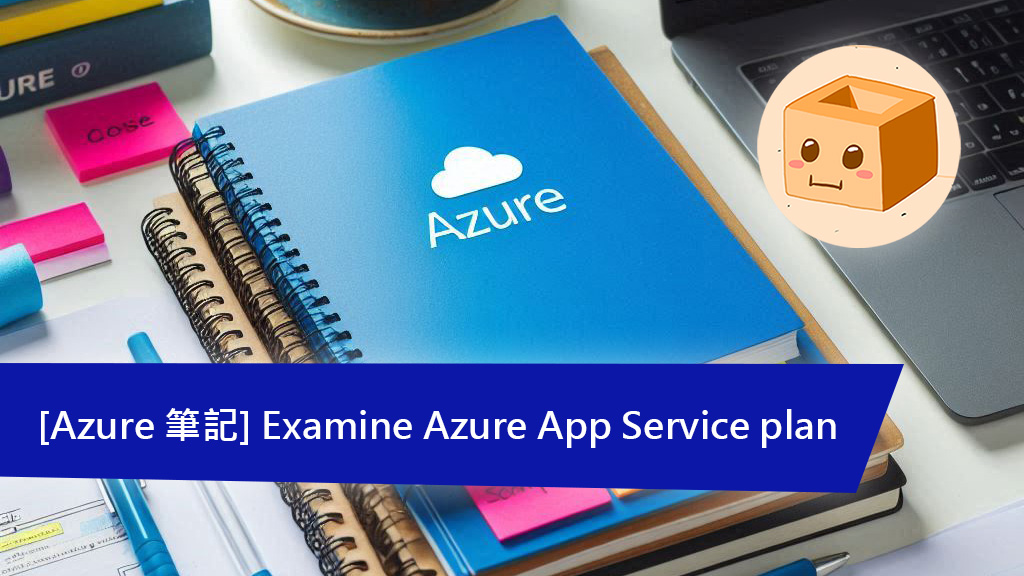前言
原文
Examine Azure App Service plans
小結
Azure service plan 就是一組用於運行 Azure Service 的資源
一個或多個的 Azure Service 都可以運行於一個 Azure Service plan 內
你可以在 Azure Service Plan 內設定 Azure Service 的資源配置
當中包括了:
- 操作系統 (Windows, Linux)
- 地區 (West US, East US, etc.)
- VM instances 的數量
- VM instances 的大小 (Small, Medium, Large)
- Pricing tier (Free, Shared, Basic, Standard, Premium, PremiumV2, PremiumV3, Isolated, IsolatedV2)
Pricing tier
Free 和 Shared 這兩個 tier 是需要跟其他用戶一起共用 Azure VM 的
自然也就不能執行 Scaling (in/out/up/down) 的操作
這些 tier 也都會被分得 CPU quotas 以用作執行 Azure Service apps
這兩個 tier 也都只建議是被用作 development 或 testing
而其他的 tier 都是以 Azure Service plan 作 computational resources 的劃分
也可以進行 scaling 的操作
Isolated 和 Isolated V2 這兩個 tier 比較特別
它們都是在指定的 Azure Virtual Network 上運行的
因而它們有特 Network isolation 的特性
同時它們也有最大的 scale-out capabilities
Computational resources
Scaling 是執行於 Azure service plan 的
因而會同時應用到所有在這個 plan 內的 apps
例如如果這個 plan 有兩個 VM instances
那麼這個 plan 內的所有 apps 就會同時運行在這兩個 VM instances 內
同時,一些附帶的服務都會在這些 VM 內運行,共享這些資源
例如,如果你有數個 deployment slots
這些 slots 全都會在 plan 內的 VM 運行
又例如,如果你啟用了 diagnostic logs, perform backups, run WebJobs,它們都會在 plan 內的全部 VM 上運行 (i.e. 如果你有 1 個 apps 和 5 個 VM instances,那麼就有 5 個相同的 apps 分別在這 5 個 VM 上運行)
文本摘錄
What is Azure App Service plans
In App Service, an app always runs in an App Service plan.
An App Service plan defines a set of compute resources for a web app to run.
One or more apps can be configured to run on the same computing resources (or in the same App Service plan).
What is configured in a App Service plan?
Each App Service plan defines:
- Operating System (Windows, Linux)
- Region (West US, East US, etc.)
- Number of VM instances
- Size of VM instances (Small, Medium, Large)
- Pricing tier (Free, Shared, Basic, Standard, Premium, PremiumV2, PremiumV3, Isolated, IsolatedV2)
Pricing tier
The pricing tier of an App Service plan determines what App Service features you get and how much you pay for the plan.
Shared compute
The Free and Shared tiers, run the apps with other customers on the same Azure VM.
These tiers allocate CPU quotas to each app that runs on the shared resources, and the resources can’t scale out.
These tiers are intended to be used only for development and testing purposes.
Dedicated compute
The Basic, Standard, Premium, PremiumV2, and PremiumV3 tiers run apps on dedicated Azure VMs.
Only the apps in same App Service plan share the same compute resources.
The higher the tier, the more VM instances are available to you for scale-out.
Isolated
The Isolated and IsolatedV2 tiers run dedicated Azure VMs on dedicated Azure Virtual Networks.
It provides network isolation and the maximum scale-out capabilities.
How does my app run and scale?
For Free and Shared tiers, apps running on the shared VM and instances and it cannot be scaled out.
For the other tiers, they run and scales as follow:
- An app runs on all the VM instances configured in the App Service plan.
- If multiple apps are in the same App Service plan, they all share the same VM instances.
- If you have multiple deployment slots for an app, all deployment slots also run on the same VM instances.
- If you enable diagnostic logs, perform backups, or run WebJobs, they also use CPU cycles and memory on these VM instances.
App Service plan is the scale unit.
If the plan is configured to run five VM instances, then all apps in the plan run on all five instances. If the plan is configured for autoscaling, then all apps in the plan are scaled out together based on the autoscale settings.
What if my app needs more capabilities or features?
App Service plan can be scaled up and down at any time.
If you want to improve the app’s performance by isolating the compute resources. You can do it by moving the app into a separate App Service plan.
You can potentially save money by putting multiple apps into one App Service plan.
Isolate your app into a new App Service plan when:
- The app is resource-intensive.
- You want to scale the app independently from the other apps in the existing plan.
- The app needs resource in a different geographical region.

![[資安快訊] Apple、Microsoft、Google Chrome 釋出高危漏洞修補版本,請盡快更新](https://thinkdb.link/wp-content/uploads/2025/03/update.jpg)
![[碰壁指南] SSH config,從入門到取代跨平台 SSH 工具](https://thinkdb.link/wp-content/uploads/2025/03/ssh-config.jpg)
![[AZ-204] Connect functions to Azure services](https://thinkdb.link/wp-content/uploads/2025/02/Connect-functions-to-Azure-services.jpg)
![[AZ-204] Create triggers and bindings](https://thinkdb.link/wp-content/uploads/2025/02/Create-triggers-and-bindings.jpg)
發佈留言